Kanazawa
Fri 16 Sep 2011 by mskala Tags used: travelI'm titling this entry "Kanazawa" but in fact that's just my base of operations; much of what I've done in the last few days has been in the surrounding region.
I arrived by train in Kanazawa Wednesday night, and my first thought was "My God, it's full of schoolgirls!" On sober reflection I figured out that actually there were an equal number of boys in uniform too - it's just that a Japanese schoolboy uniform, at least in this season, is just black slacks and a white shirt, so I naturally confused them with Mormons. Boy or girl, the number seems really abnormal, and they hang around downtown until late enough that it seems surprising to me that their parents allow it. After almost two weeks in Japan I had been starting to get the idea that maybe some people actually look like that for real (not cosplay), and that this place might possibly be an actual country and not a 24-7 comic book convention; but on arriving in Kanazawa I was not so sure.
After seeing a bit of the countryside and thinking some more, my current hypothesis is that the malls of Kanazawa are A. the most fun a teenager can have for some considerable distance in any direction (the alternative is to sit in a rice field and watch television); B. accessible for a larger radius, and thus to a larger number of suburban teenagers, than I'd expect for a similar-sized North American city, because of the superior public transit system here; and C. still safe enough (because this is Japan, and a pretty small city, just under half a million population) that the kids' parents do allow them to spend their evenings this way.
Anyway, I turned in early on Wednesday, and got up raring to go for my trip to Keta Taisha, near Hakui. I guess I shouldn't choose highlights of my trip before the trip is complete, but Keta Taisha was certainly near the top of my priority list for places I wanted to go when I was planning this trip.
Keta Taisha is (as the name taisha suggests) a "grand shrine," one of the major ones in the pre-war ranking. It enshrines Ookuninushi-no-mikami, the god of marriage, and has a reputation as a "matchmaking shrine," frequented by young women looking for love and marriage. If you visit its Web site you can read (in Japanese) some of the testimonial letters sent in by pilgrims. The typical one reads something like "Dear God at Keta Taisha, I never thought it could happen to me! Thank you for always watching over me, blah blah blah, pilgrimage to Keta Taisha, blah blah blah, and suki na So-and-so-senpai ["beloved upperclassman So-and-so"] finally emailed me!"
The tourist guides tell you to take the train to Hakui (population 23,800; highest density of UFO sightings in Japan; one hour North of Kanazawa) and ride a bus (10 minutes, but busses run hourly or less) from the train station to the shrine. I decided instead to take the train one stop further, to Chiji (population: tire), and then walk. I figured it would feel more like a pilgrimage that way; and I didn't really want to deal with figuring out how to ride the bus (MOST busses work on the "free ticket when you get on saying where you got on, pay when you get off depending on how many stops since you got on" system, but not ALL busses work that way, and if not you're on your own); and with the busses so infrequent, it wasn't clear that I'd get there any faster than walking anyway. The train stations of Hakui and Chiji, and the shrine, form roughly an equilateral triangle with a little under an hour's walking distance between them. The walk between Chiji and Keta Taisha looked on the satellite photos to be pleasanter and easier to navigate (it is more rural, and straight along the forest/rice field boundary, instead of through the suburban area of Hakui) so I took the train to Chiji.
I was glad I did it that way. The Chiji train station was very cute; see photos. I don't think "Chiji" is a real place (like a town or whatever) at all; they just had to have a name for the train station. There's a spot to park bicycles, and a convenience store nearby, but it's basically in the middle of a suburban residential area, on the boundary between the rice fields and the forest. The station doesn't have a staffed ticket window or the kind of ticket gate you see in proper cities, where you put your ticket in and it either cancels it (recording "you got on at this time and place") and gives it back, or just swallows it if you are at the end of your journey. Instead, there's just a box where you're supposed to leave your spent ticket if you feel like doing so, and a machine (NOT one of the fancy ones with a video display like in town) to sell you new tickets if you're embarking, and presumably the conductor on the train will cancel your ticket after you get on, if the train happens to have a conductor and the conductor feels like bothering.
The walk went pretty much perfectly. Unlike my consistent experience trying to use printed-out Google maps in cities, everything was where I expected it to be and looked enough like I expected it to, that I always knew where I was. I wrote before about how the basic landscape in Japan seems to be patches of flat rice fields with suburban dwellings, and forest-covered mountains. The walk from Chiji to Keta Taisha was along one of those boundaries. Sometimes I had houses on both sides; other times I had bushes on both sides; and much of the time it was forest on the right and rice fields on the left.
There were a few other shrines along the way, each set some distance back into the woods, and correspondingly above the rice-field level, with stairs leading up. They were clearly much less visited than Keta Taisha, and made for an interesting contrast. A couple of them didn't have any water or ladles in the purification fonts; one didn't even seem to have a donation box, which is not quite sacrilege but certainly unusual. A place is a shrine by definition if and only if it has a god in it; but taking monetary donations is also pretty high up on the list of the usual expectations.
The shrine at Keta Taisha seems less commercialized than the one for let's say Billiken (it'd have a job not to be) - people still seem to worship seriously here - and it was less thronged with visitors than I expected based on the videos I saw on its Web site. I think a Thursday mid-day is probably not the busy time. There were a few of what were presumably marriage-minded women, in groups of two or four, taking photos and buying omikuji and giggling. There was a tour group of senior citizens who arrived on a bus and were led around by a guide, and they all waited politely when I arrived at one of the subsidiary shrines a few seconds before them, then each took their own turn to do the coin-bell-bow-bow-clap-pray-bow routine. I saw no other non-Japanese people and heard no English spoken (except in the videos at the space museum) for the whole trip.
I saw only one shrine-maiden on duty for the whole place, and he turned out to be a boy. I didn't even know that was allowed; what should I call him, a shrine-lad? But I suppose it makes a sort of sense. It's no secret (as discussed in Lucky Star) that part of the point of having cute shrine-maidens is to encourage men to visit the shrine (and this has been the case for hundreds of years) so if it's a shrine that caters to women, why not shrine-lads?
But even if not completely oriented to commercial tourism, you could tell Keta Taisha was a "going concern." Lots of bins of omikuji fortunes for sale on the "put money in the box and take one" system; I bought one regular (100円) and one "love" (200円) omikuji, which turned out to be respectively "small blessing" and "medium blessing." These were all in Japanese, unlike the one I got earlier from Nanbayasaka Jinja. There were also kodomo no ("children's") omikuji available.
There were many racks of ema (wooden offertory plaques inscribed with prayers - the word actually means "horse" because these evolved from an earlier practice of donating actual horses), which at this shrine have heart graphics. My favourite simply said 「どうか。ラブラブになれますように Y」, which is difficult to translate because it uses passive voice (which generally sounds formal in English, but isn't, here) along with the slang term ラブラブ ("lovey-dovey") to describe what Y wants. I hope she gets it!
I bought a charm from the shrine-lad. Charms are also a big part of the business of this shrine, and not only love charms but also charms for doing well on university entrance exams, avoiding traffic accidents, spiritual advancement, protection from disease, and pretty much anything else you want. They have big posters at the charm shop with pictures of all the different charms, their model numbers, and what they are good for. The charms are in bins below, in clear envelopes with numbers so you can be pretty sure you get the one you want, then you take it to the sales window and pay the shrine-lad. He probably does something to "activate" it at the time of purchase, just like a gift card. The names and descriptions were written with a lot of difficult words I didn't know, so it wasn't easy to choose. I selected one called 「心むすび」, which turns out to mean "lover's knot" or "heart connection," and was probably the right one.
There seems to be a Buddhist facility right next door to Keta Taisha (recognizable by the bell, statue of Kannon, and so on). I took some photos of it, but I don't really know much about it, so I guess you can just go look at the photos.
Shinto shrines, especially large ones, often have several entrances with a lengthy approach in front of the main entrance, with a couple of torii along the way. At Keta Taisha this approach actually starts at the seaside, so even though I had arrived by the side entrance, I went down to the beach and took some photos there. I found there was a nice footpath leading along the coast toward Hakui, so I decided to return that way and see some other kinds of scenery, instead of going back the way I come, via Chiji Station.
Arriving in Hakui about a quarter to two, I faced the choice of whether to wait for the train back to Kanazawa or stay a bit longer. I decided to stay a bit longer, and went to the space museum "Cosmo Isle Hakui." Buying a ticket in Japanese was okay, but the ticket clerk spent a bit of time trying to offer me what I think may have been a set of audio tour headphones, and we didn't really manage to communicate. I also had trouble on the elevator because of not remembering, of 開 and 閉, which one is "open" and which one is "close." (I thought I had memorized a mnemonic "o (オ) is for open," but that turns out not to be correct.) But the exhibits themselves, somewhat to my surprise, were all bilingual. Many of the videos were interviews of English speakers anyway, dubbed into Japanese, so it was probably easy for them to just show the original if you pressed the button for that.
Cosmo Isle Hakui has two floors - one of which seems to be a planetarium show type of thing, and the other (which is where I went) is the usual kind of museum. It's mostly like a small-town "space museum" you might see anywhere, with a bunch of models of different space exploration vehicles and signs describing the history of space exploration. Cosmo Isle Hakui also treated flying saucer space aliens at least semi-seriously. I think Hakui is quite proud of being the UFO capital of Japan. Many of the trains on the JR Nanao Line, which is the one serving Hakui, have UFO livery.
One thing I noticed about Cosmo Isle, and which reminded me of the Instant Ramen Museum and is probably a typical thing of Japanese museums, was that there seemed to be a significant focus on individuals. There was a wall of names, photos, and one-paragraph bios of the top space scientists: Francis Drake (of the SETI Institute, not "Sir"), Freeman Dyson, and eight men I'd never heard of, with the Japanese one right at the top. Then in the two video-viewing rooms you could choose via touch screen to watch interviews in Japanese or English with any of about 20 people who seemed to be more or less randomly chosen characters with PhDs, or UFO nuts, or both. I'm sure they will contact me for an interview when it comes time to record their next batch of tapes. Unfortunately, the audio volume was inconsistent and non-adjustable, so some of the interviews weren't much use.
As I was leaving the space museum level, I saw the crowd exiting the planetarium show which had just finished, and it was all middle-aged men in suits. If the malls of Kanazawa are the most fun teenagers can have in this region, is Cosmo Isle Hakui the hot spot for salarymen on a Thursday afternoon? I don't know.
I bought an ice cream cone (ソフトクリーム, sofuto kuriimu "soft cream") at the Cosmo Isle Hakui snack bar, and handled the Japanese perfectly, to the amazement of the snack bar lady and some customers who were hanging out there. Then I got on the train back to Kanazawa, had dinner, and uploaded photos.
It's worth mentioning the food in Kanazawa. Yuya-sensei told me that sampling the seafood in Kanazawa, like the Bunny-chans in Osaka (Bunnies-chan?) is "if you don't do it, that is not good," and I think he was right. I skipped the hotel breakfast (not included with my room, and 2500円) in favour of convenience-store onigiri to eat for brunch on the train, all three mornings. But for dinner each night I pushed my way through the crowds of sailor-uniform kids to the sixth floor of the FORUS shopping mall next to the Kanazawa train station, where there was what they called a "dining resort," basically an upscale food court. The food was so good there I didn't make it any further.
On Wednesday night, I had Japanese-style Chinese food, consisting of mixed seafood in a thick sauce, with noodles. On Thursday, I went to what billed itself as a "Gumbo and Oyster Bar" and had the "oyster set meal," which was really more of a tasting menu of five different oyster dishes and some other stuff on the side. With a beer it came to 2180円 and seemed very good value. That was probably my favourite meal in Kanazawa. On Friday night I went to a katsu (fried cutlet - I overheard some Germans call it "schnitzel") place and had what might be called a "pork composite" cutlet, thin slices of pork layered with pickled plums and pressed back into a cutlet shape before being breaded and fried. This sounds weird but was pretty good. (Still some seafood in this meal: tiny clams, shells and all, in the miso soup.)
My plan for Friday was to go South and visit Shirayama Hime Jinja, the head shrine of the Mt. Haku shrine network. I'm going to stick to calling it "Mt. Haku," but most English sources seem to call it "Mt. Hakusan," which I think is bad practice. The "-san" suffix has the same meaning as "Mt.", so that's kind of like "ATM machine." (This is not the same "-san" as used with people's names; that one is usually spelled 「さん」 and the one for mountains is 「山」.) We say "Mt. Fuji" or "Fujisan," not "Mt. Fujisan," and for the same reason I'm going to say "Mt. Haku."
"Hakusan" (Mt. Haku) is written 「白山」, and those characters (which mean "white mountain") can also be read "Shirayama," as in the name of the shrine. Anime fans probably know that "hime" means "princess," but that is 「姫」 (also seen in Raven's tattoo in Questionable Content) and the "hime" in the name of the shrine is 「比め」 (second character should be a kanji pronounced "me" instead of め). I can't even find the second kanji in my database to type it, and I don't know what it means (the first is "comparison"); maybe that's why the "me" syllable is also written in kana on many of the signs. It's a reasonable guess that "Hime Jinja" is a shrine rank like "Taisha." Anyway, it's the same pronunciation as "princess," but a different word.
ETA: I managed to find the other character online; the correct spelling of the shrine name is 「白山比咩神社」. Kanjidic2 says「咩」 means "the bleating of sheep" and is normally pronounced ビ or ミ, not め ("bi" or "mi", not "me"). No hits on it in WWWJDIC, it's not part of the standard Japanese set, and its main occurrence on the Web seems to be in the name of this shrine. "Hime" isn't the rank of the shrine, but apparently just an opaque identifier of this particular shrine.
The shrine contains the deified spirit of Mt. Haku, and there is a Mt. Haku shrine at the top of Mt. Haku, but the shrine I visited, which is the head of the Mt. Haku network, is actually located on another, smaller mountain. I'm not sure why that would be; but shrine locations are not entirely under human control and do not follow entirely human logic. As well as the kami of Mt. Haku, it is also a shrine of Izanami and Izanagi, the parents of Ebisu (as I discussed earlier).
The shrine is in the foothills of the Japanese Alps, which separate the big island into a North side (where Kanazawa is located) and a South side (which contains major population centres like Tokyo and Osaka). Nagano, where they had the Winter Olympics, is in this mountain range. Japan Rail doesn't have a station close to Shirayama Hime Jinja, so after riding JR one stop South from Kanazawa to Nishikanazawa, I had to take the private Hokuriku Railroad from Shin-nishikanazawa next door, as far as it would go. There is a train station building right next to the shrine, at Kagaichinomiya, and the Ishikawa Prefecture Tourism League will cheerfully tell you to get off the train there, but you can't. They closed Kagaichinomiya Station (and all the others past Tsurugi) in Heisei 21 (2009), so you have to go to the end of the line at Tsurugi and then make your way to the shrine by some other means. That much I'd managed to figure out on the Web while still in Canada.
What I hadn't determined yet was how, actually, to ride the Hokuriku Railroad. There was a ticket window at Shin-nishikanazawa Station but it was unoccupied. There was no ticket-vending machine. I tried to speak Japanese to the other passengers who were waiting, and probably sounded like an idiot, but I got a rough idea: "Where ticket?" "Um... inside train." "Thanks." It turned out that on this particular trip the procedure was to take a small ticket from a dispenser when boarding the car - indicating station of embarkation - and then in a few minutes the conductor would come to take the small ticket, ask your destination, and sell you a big ticket punched to show where you were going to and from, and you had just better be able to speak Japanese well enough to complete that transaction. Then you'd give the big ticket back to her when you got off. The conductor looked like Chiyo-chan, pigtails and all.
I walked from Tsurugi to the shrine, and that was not difficult - basically just following the canal until I hit the highway, at which point there were signs directing me. This shrine was more built-up than I expected; from what I'd read I expected it to be very woodsy, like the shrines on the walk from Chiji to Keta Taisha; but at least it was in a forest and had a lot of impressive trees all around. My omikuji was the best one yet - "great fortune."
I only had 10000円 notes in my pocket, so in order to have enough coins for offerings I ended up buying some cookies at the gift shop (which, in fact, I just finished eating while writing this draft). Pretty cookies in a bag with a ribbon, the kind that schoolgirls present to schoolboys in the "love confession" ritual, though I think buying cookies for that instead of making them yourself would be considered shameful. Even if you are a rotten cook and use salt instead of sugar and cook them for three hours and your boy breaks his teeth, he has to say he enjoyed it, because if you made cookies just for him and he wants to eat your cookies, it means he wants to "eat your cookies." I saw it in a love-comedy anime, so it must be true.
On the way back - same railroad, same route in the opposite direction, even the very same Chiyo-chan conductor - the procedure for riding the Hokuriku Railroad was totally different. This time, I had to buy a ticket from a machine in the Tsurugi station, and give it to a man on the platform who may have been the train driver. He stamped it and gave it back to me. (He had the same uniform as the train driver, but I'm not certain whether he got on and drove the train himself, or if that was another similar-looking man; there were several of them in the same uniform.) Then I had to show the stamped ticket to the conductor a few minutes after boarding, and give it to her when I got off the train at Shin-nishikanazawa. I felt a little better when I observed that even the Japanese people were having trouble getting the procedure right, fumbling around with tickets and stamps and "Gomennasai! Arigatou gozaimasu!" One old guy wanted to bring a grimy, heavily-laden bicycle right onto the train car, and the conductor obviously wasn't happy about that, but she let him do it.
I got back to Kanazawa mid-afternoon, but was tired enough that I didn't want to attempt more sightseeing. I just went for dinner, uploaded photos to the Net, and went to bed early.
You may recall that my home computer, in Winnipeg, crashed a few days ago and probably will be unusable until I return to Canada. I'd switched to remote-logging-in on my desktop computer at the University of Manitoba. Friday morning Japan time (which was Thursday evening Winnipeg time), that stopped working as well; so I sent email to the systems people asking them to reboot it but didn't expect it to be received until Friday morning Winnipeg time (late Friday night Japan time), and switched to the third choice, a communal server at the University of Manitoba. As of Friday evening Japan time (early Friday morning in Winnipeg), the entire Computer Science Department of the University of Manitoba was off the Net. So I switched to my third backup option, at the University of Toronto.
Saturday morning Japan time - this morning - I got up early and got on the Shirasagi Limited Express from Kanazawa to Maibara, there to transfer to the Hikari Shinkansen to Tokyo. This is not the most direct route from Kanazawa to Tokyo, but the most direct route involves taking a JR train over a non-JR section of track and paying a fee that my JR pass won't cover, to the non-JR company (it's only a small fee, but there'd be the bureaucracy of figuring out how and where to actually pay it), and I didn't want to do that. Since I would be in the area, I budgeted an extra hour for the stop-over at Maibara, and planned to visit a shrine Google Maps said was near the train station, as well as having extra slack time for making my connection and buying a lunch to eat on the shinkansen.
The shrine near Maibara Station actually turned out to be a complex of several, plus a playground, and a hiking trail that looked closed. I'm going to have to do some research and figure out what the shrines all were; one was clearly an Inari shrine (foxes, corridor of many small torii), and from reading the signs I guessed that another was for a deified former Emperor, but the others I'm not sure about.
Visiting all those shrines took up most of my hour, and I barely had time to grab a small box-lunch in the station konbini and grab my suitcase out of the only extra-large luggage locker in Maibara, before it was time to board my train. And now, here I am on the train. As I finish writing this, we are at Shinagawa, just a few minutes from Tokyo.
Hokuriku Railroad, Shin-nishikanazawa Station
The English label on the station sign says "Hokutetsu," which is a nickname for "Hokuriku Tetsudou" - the Hokuriku Railroad.
JR Nishikanazawa Station
JAIST Festival
Hokuriku Railroad, Tsurugi Station
warning sign near canal
"Playing in the water here is not allowed - Ishikawa Prefecture."
Blue road sign indicates that Shirayama Hime Jinja (白山比咩神社) is to the right.
Yangu Dry Cleaning
tanuki with stick
Tanuki are nearly always depicted as males with large testicles. Originally that was culturally significant, but I'm pretty sure that now the main reason is because people think it's amusing.
tanuki with abacus
My tutor was quite surprised to find out that the word "abacus" exists in English; he'd thought that the 算盤 ("soroban") was unique to East Asia and had no translation.
caution - frequent bear sightings
Hokuriku Railroad, Kagaichinomiya Station (closed)
Sign at lower left explains that the station was closed on November 1, 2009. To this day, however, the web site of the Ishikawa Prefecture Tourism League tells you to get off here for Shirayama Hime Jinja.
If it were my home, I wouldn't be so calm.
I'm pretty sure that the English text is an accurate translation of the Japanese, and that it doesn't really make any more sense in Japanese. What they're implying *may* be that you should be careful not to set fire to the ashtray, but that's not at all clear.
Shirayama Hime Jinja - this way
Shrine guardians usually come in pairs. Lions are the default, but some gods and some shrines have other guardians. Usually the one on the left as you face the shrine from the outside has its mouth closed (this is such a guardian), and the one on the right (next image) has its mouth open.
Shirayama omikuji number 45 - Great Fortune
The characters for "great fortune," 大吉, near upper right, indicate that this is one of the good ones, but I haven't worked out most of the rest yet.
dog doings forbidden!
overgrown railway track near closed Kagaichinomiya Station
Can you even see the tracks? Less than two years ago this was in active service.
The characters for "offering" (often seen on the donation boxes at shrines) are apparently spelled out here in offered coins.
LIQUOR SHOP
Alcohol vending machine. Items range from a can of low-end beer for 130円, to what I think, if I'm reading the label right, is half a gallon of 25% grain alcohol for 980円 (lower right), at which price it can't possibly be very good. The sweet-potato-based 25% alcohol, same amount for 200円 more (lower left), may be a safer choice, but is still awfully cheap, and actually drinking either of them may be a bad idea.
shop selling document seals
Note how the kanji on the sign, and on the windows, are written in the squiggly "seal script" instead of the modern style. Most people who can read kanji can't actually read seal script anymore; it is several centuries out of date for basically all purposes except seals like the ones sold by this shop.
Hokuriku Railroad ticket
Hokuriku Railroad (北陸鉄道), purchased at Tsurugi (鶴来), date September 16, 2011 (the year is "23" for Heisei 23), price 440 yen adult or 220 yen child, which is enough to get to Shin-nishikanazawa. Note the green cancellation stamp for September 16.
train driver at Tsurugi (つるぎ)
Study in English every day at Kanazawa College
1 comment
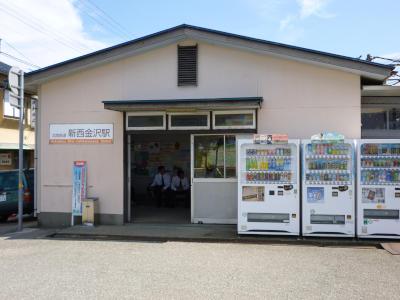
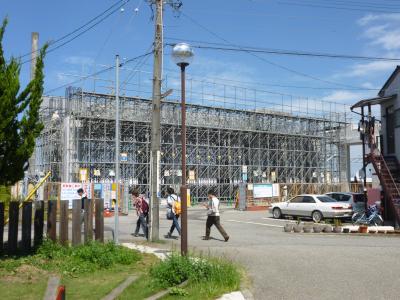


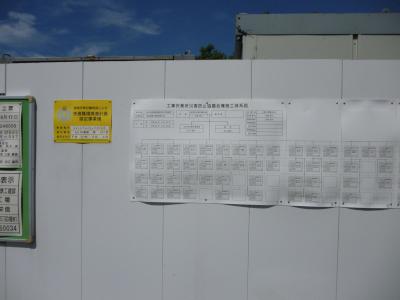


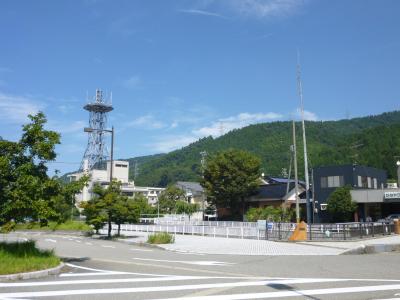


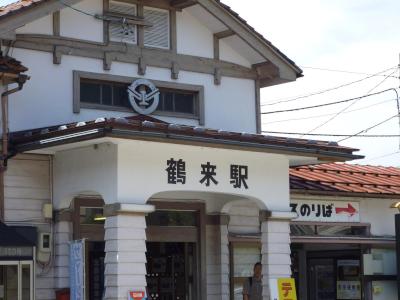
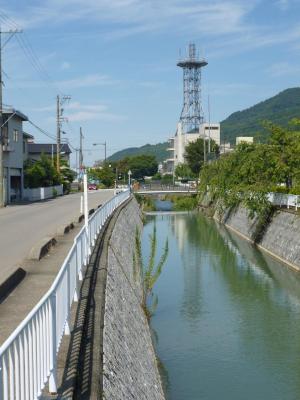

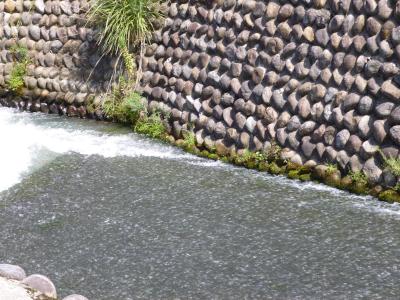
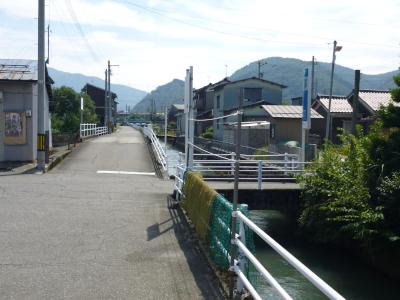
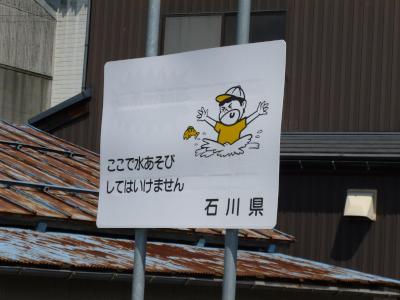
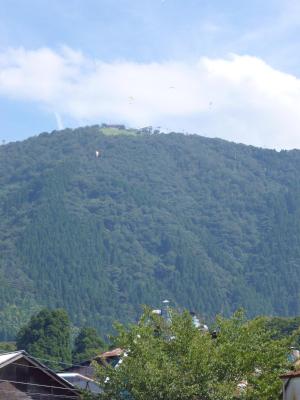
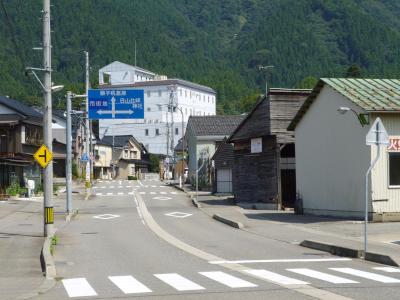
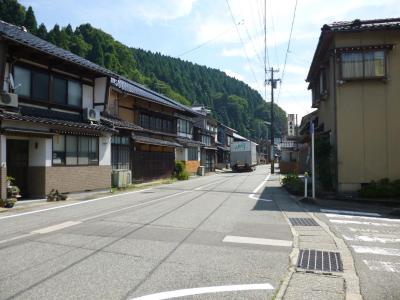

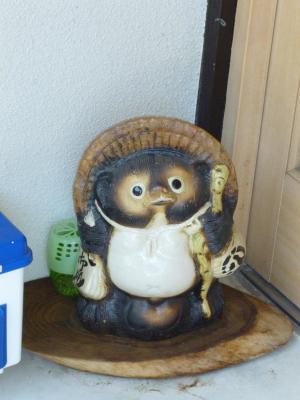

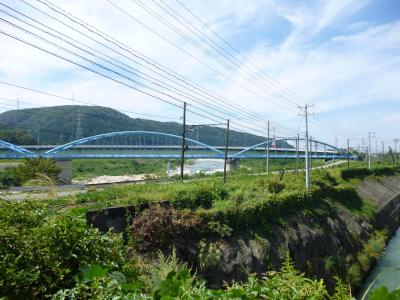
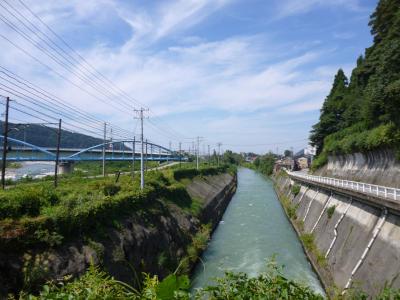


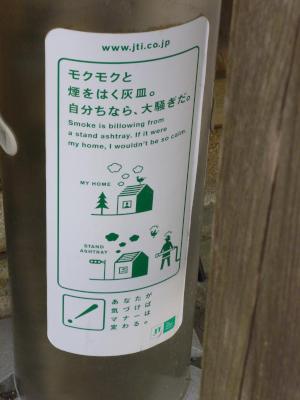
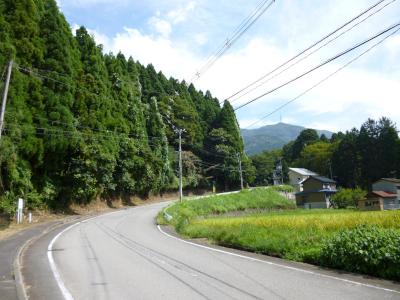
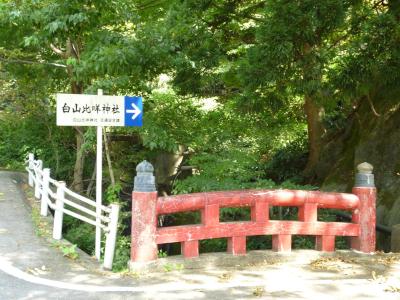
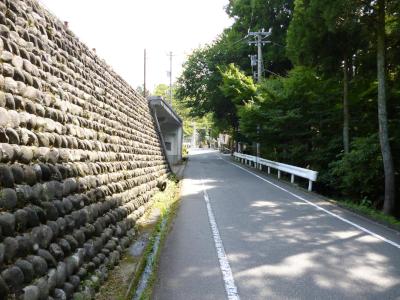

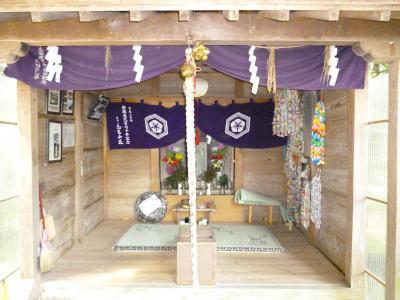


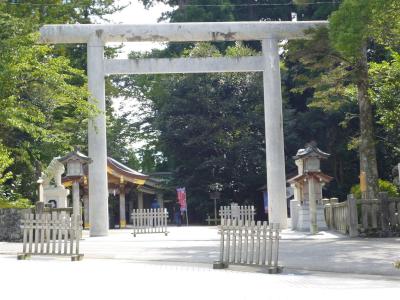
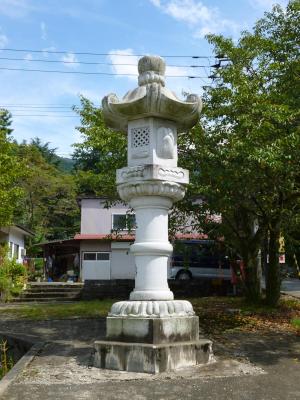
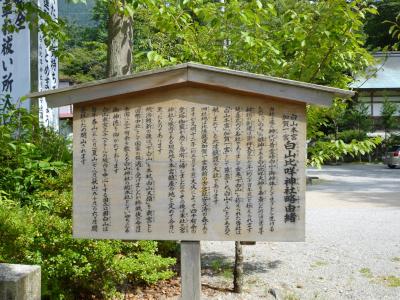
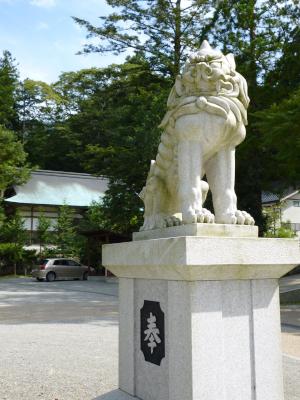

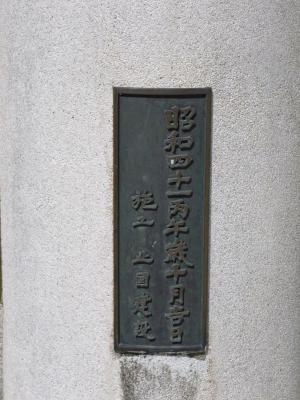
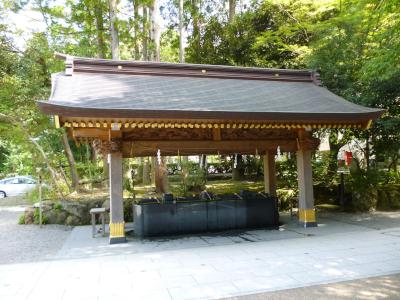
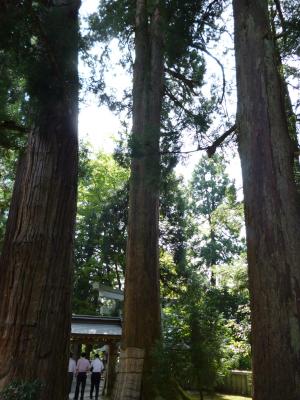
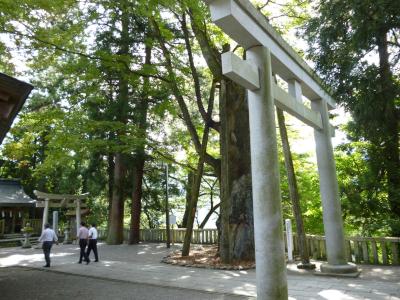
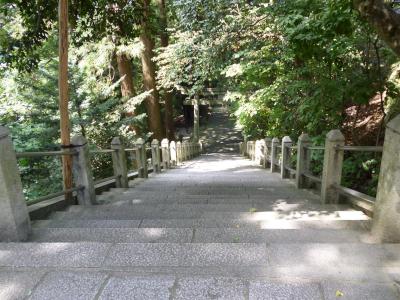

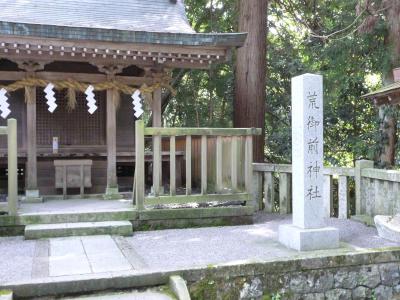
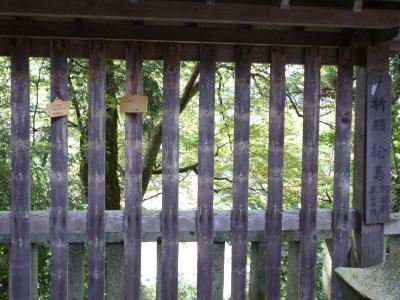
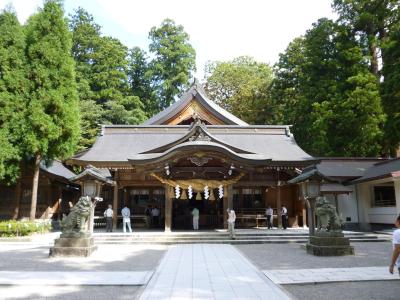
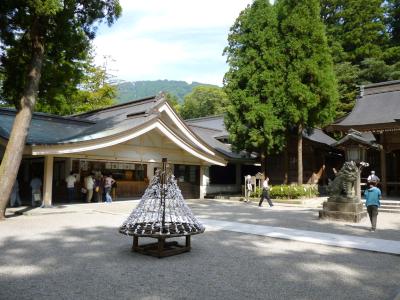
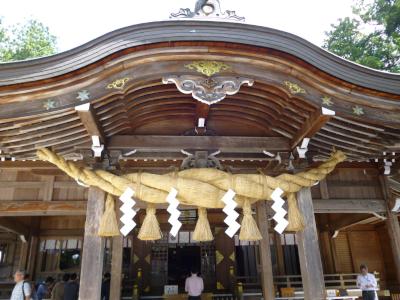

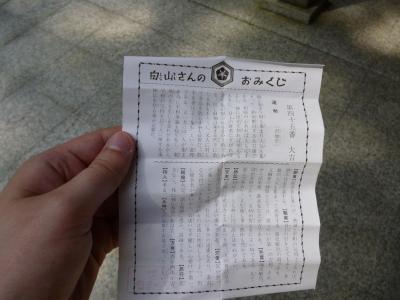
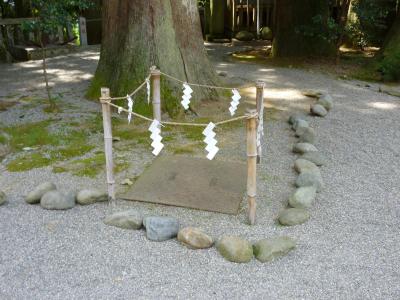
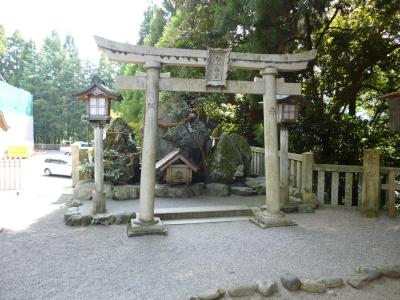

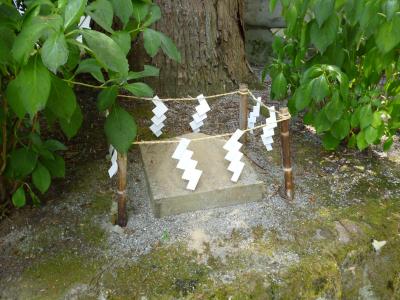

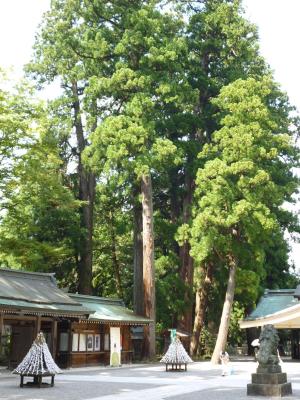
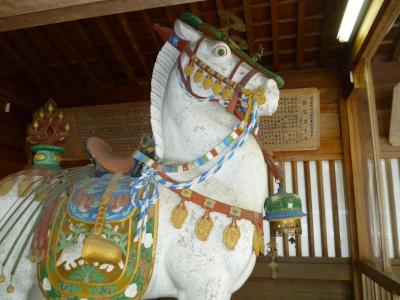
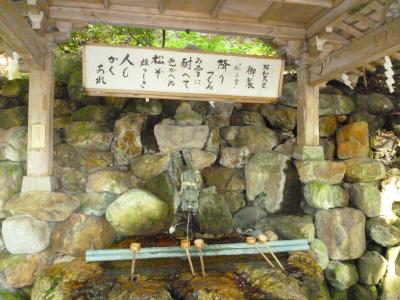

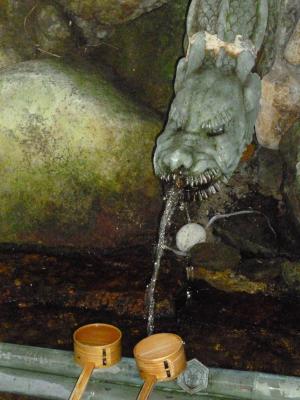
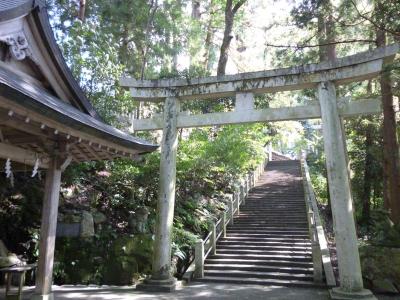


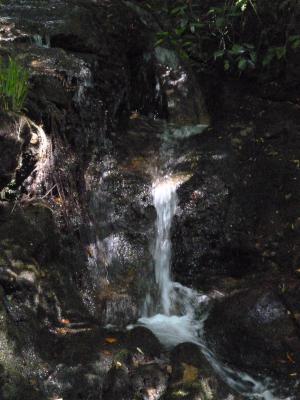
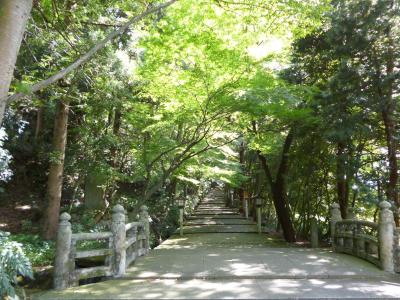
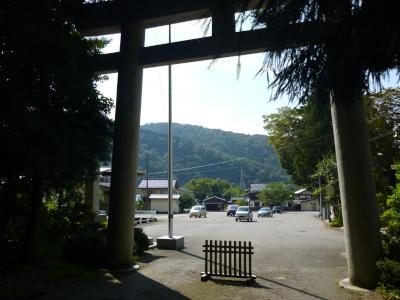
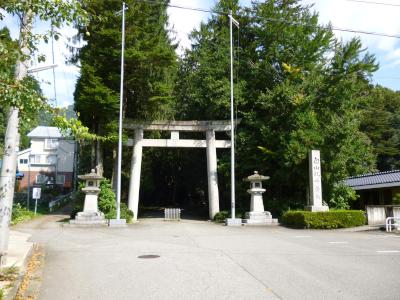
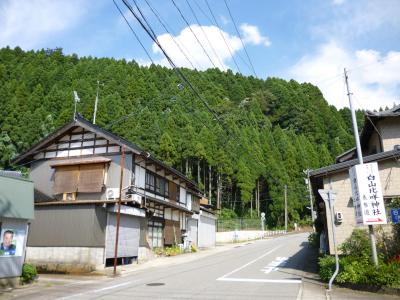
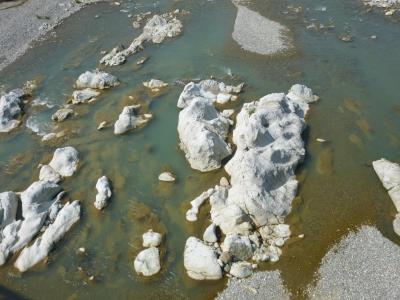


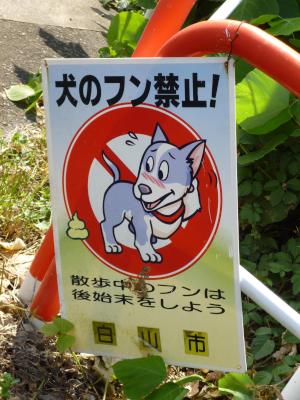
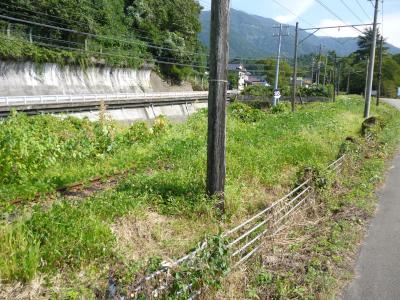
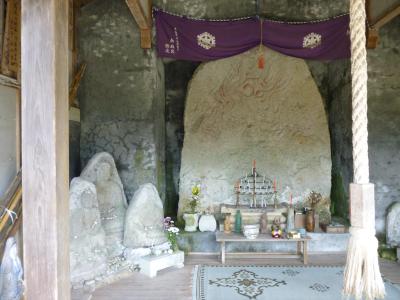
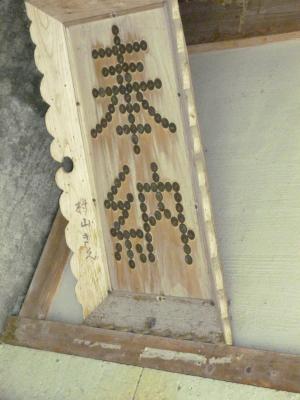
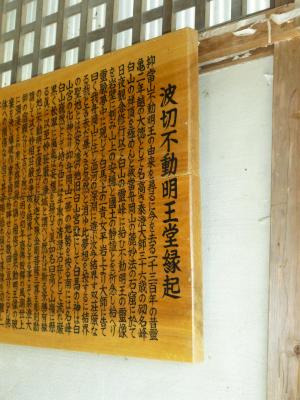
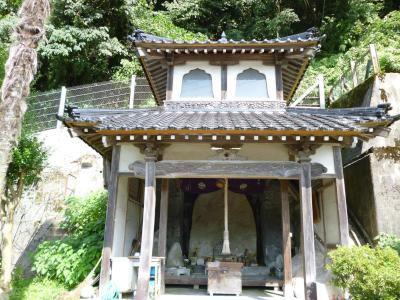

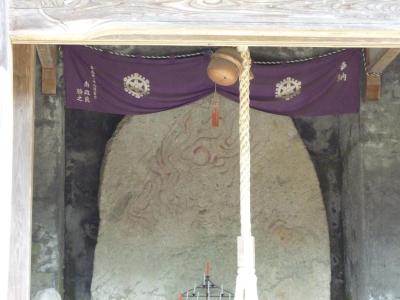
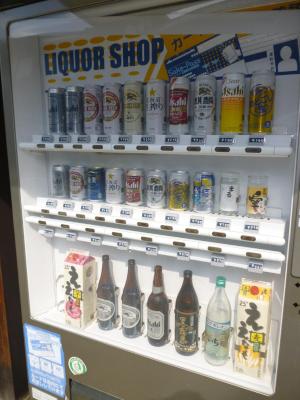



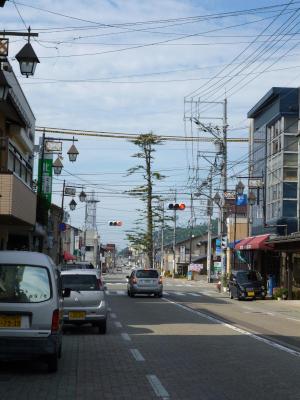
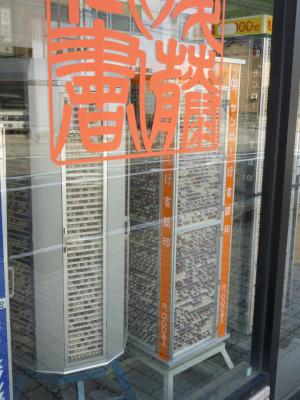
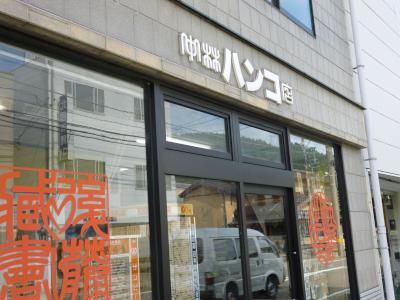
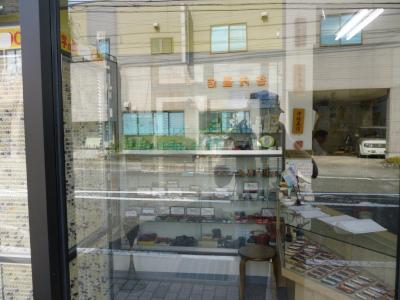
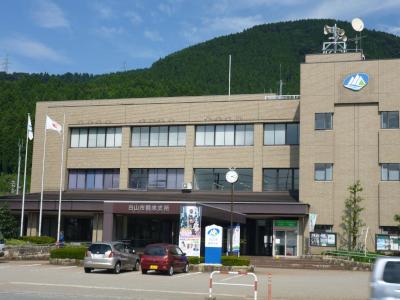
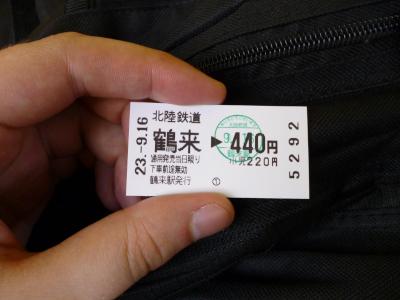
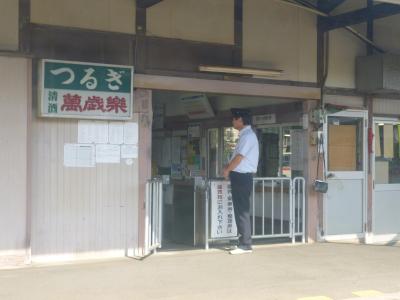
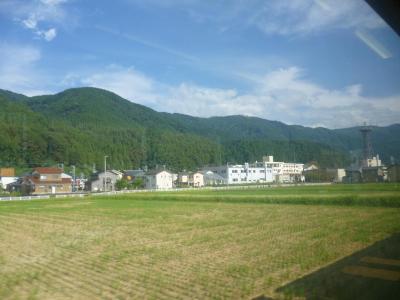

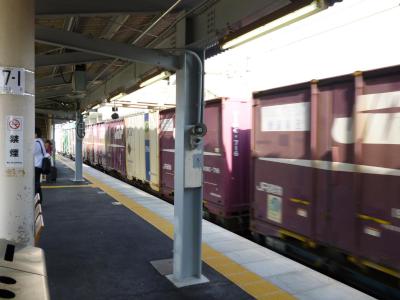
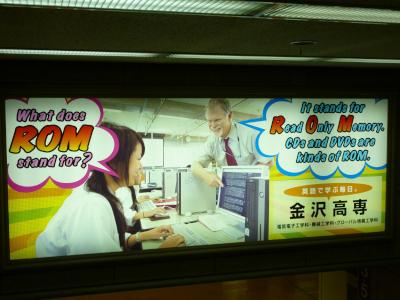

Beth Skala - 2011-09-18 16:20